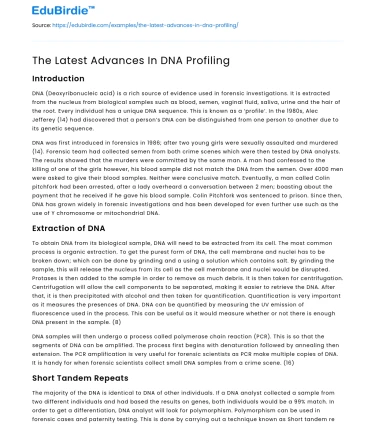Introduction
DNA (Deoxyribonucleic acid) is a rich source of evidence used in forensic investigations. It is extracted from the nucleus from biological samples such as blood, semen, vaginal fluid, saliva, urine and the hair of the root. Every individual has a unique DNA sequence. This is known as a ‘profile’. In the 1980s, Alec Jefferey (14) had discovered that a person’s DNA can be distinguished from one person to another due to its genetic sequence.
DNA was first introduced in forensics in 1986; after two young girls were sexually assaulted and murdered (14). Forensic team had collected semen from both crime scenes which were then tested by DNA analysts. The results showed that the murders were committed by the same man. A man had confessed to the killing of one of the girls however, his blood sample did not match the DNA from the semen. Over 4000 men were asked to give their blood samples. Neither were conclusive match. Eventually, a man called Colin pitchfork had been arrested, after a lady overheard a conversation between 2 men; boasting about the payment that he received if he gave his blood sample. Colin Pitchfork was sentenced to prison. Since then, DNA has grown widely in forensic investigations and has been developed for even further use such as the use of Y chromosome or mitochondrial DNA.
Extraction of DNA
To obtain DNA from its biological sample, DNA will need to be extracted from its cell. The most common process is organic extraction. To get the purest form of DNA, the cell membrane and nuclei has to be broken down; which can be done by grinding and a using a solution which contains salt. By grinding the sample, this will release the nucleus from its cell as the cell membrane and nuclei would be disrupted. Protases is then added to the sample in order to remove as much debris. It is then taken for centrifugation. Centrifugation will allow the cell components to be separated, making it easier to retrieve the DNA. After that, it is then precipitated with alcohol and then taken for quantification. Quantification is very important as it measures the presences of DNA. DNA can be quantified by measuring the UV emission of fluorescence used in the process. This can be useful as it would measure whether or not there is enough DNA present in the sample. (8)
DNA samples will then undergo a process called polymerase chain reaction (PCR). This is so that the segments of DNA can be amplified. The process first begins with denaturation followed by annealing then extension. The PCR amplification is very useful for forensic scientists as PCR make multiple copies of DNA. It is handy for when forensic scientists collect small DNA samples from a crime scene. (16)
Short Tandem Repeats
The majority of the DNA is identical to DNA of other individuals. If a DNA analyst collected a sample from two different individuals and had based the results on genes, both individuals would be a 99% match. In order to get a differentiation, DNA analyst will look for polymorphism. Polymorphism can be used in forensic cases and paternity testing. This is done by carrying out a technique known as Short tandem repeats (STR). STRs look for a non-coding region as it holds a repetitive sequence which consist of 2-7 base pairs. The non-coding regions are called introns and the coding regions for proteins are called exons. Introns and exons are both sections found in RNA transcripts. (16)
Y chromosome
23 chromosomes are inherited from the mother and father. There are 22 pairs of chromosomes and the 23rd chromosome is the sex marker. A woman will be marked XX and a male will be marked XY. The Y chromosome is an important chromosome for DNA analysts as it can be used in violent and sexual assault cases. DNA analysts will be looking for the Y chromosome to identify a male profile. Y-STRs are widely used in sexually assault cases. When there are mixed profiles in biological evidence(13), this can be used to differentiate the male profile and female profile. This is because a sufficient amount of the male’s profile DNA would be present. (11)
MtDNA
DNA can also be obtained from the mitochondria as well as the nucleus. However, a DNA analyst would much rather obtain DNA from the nucleus instead of the mitochondria. This is because, the mitochondria is strictly inherited from the mother, therefore the DNA sequence will not be unique. This is because mtdna has little non-coding DNA therefore very little variation between two individuals., making it difficult to get a full profile of the individual. (15) On the other hand, mtDNA is robust unlike nucleic DNA. If DNA from the mitochondria is damaged or old, it is more likely that DNA can be extracted and analysed unlike the nucleic DNA which is not robust and can die over time. (4)
In conclusion, DNA profiling has grown widely in forensics since the 1980s, as DNA is not just useful for catching culprits, but it is also used to bring justice for the innocence. DNA should not always be relied upon as it is very easy to have contaminated evidence, which could lead to making false accusations.






 Stuck on your essay?
Stuck on your essay?

